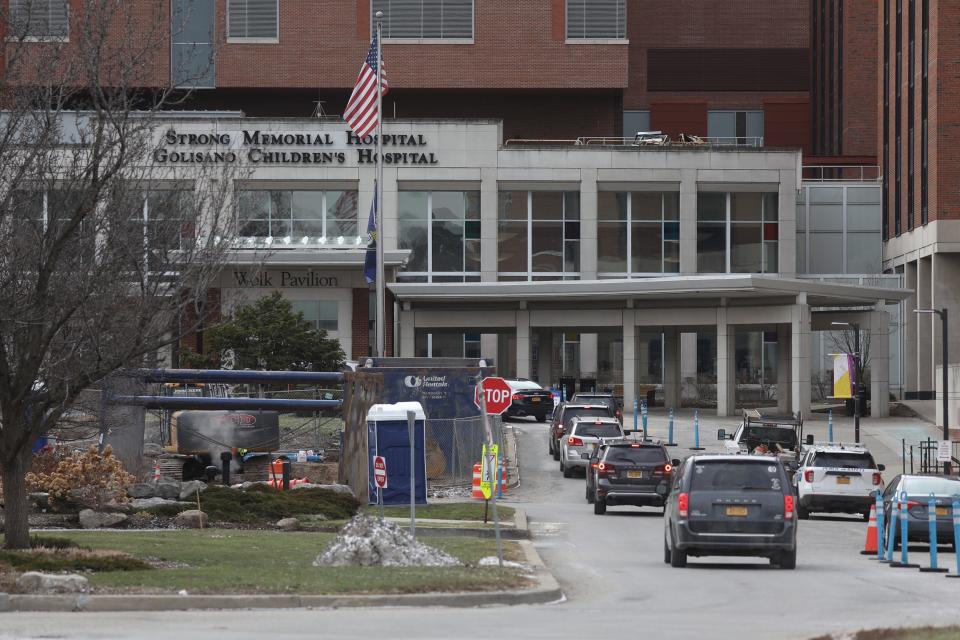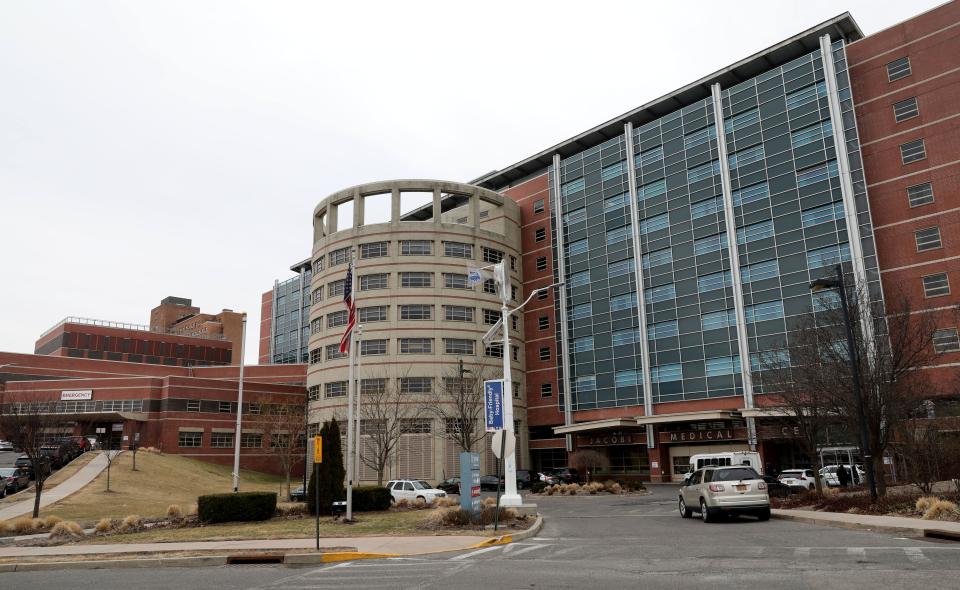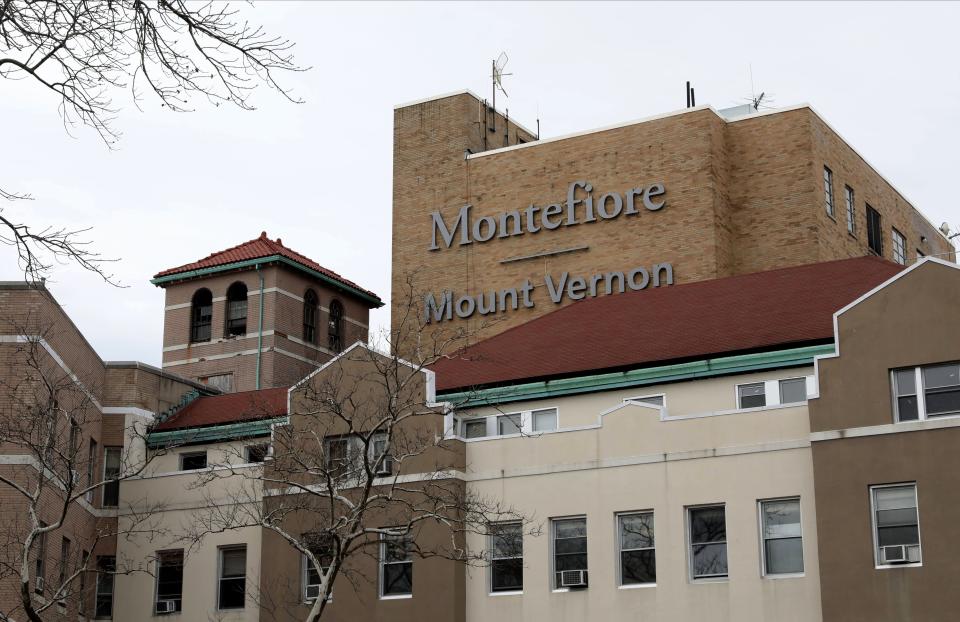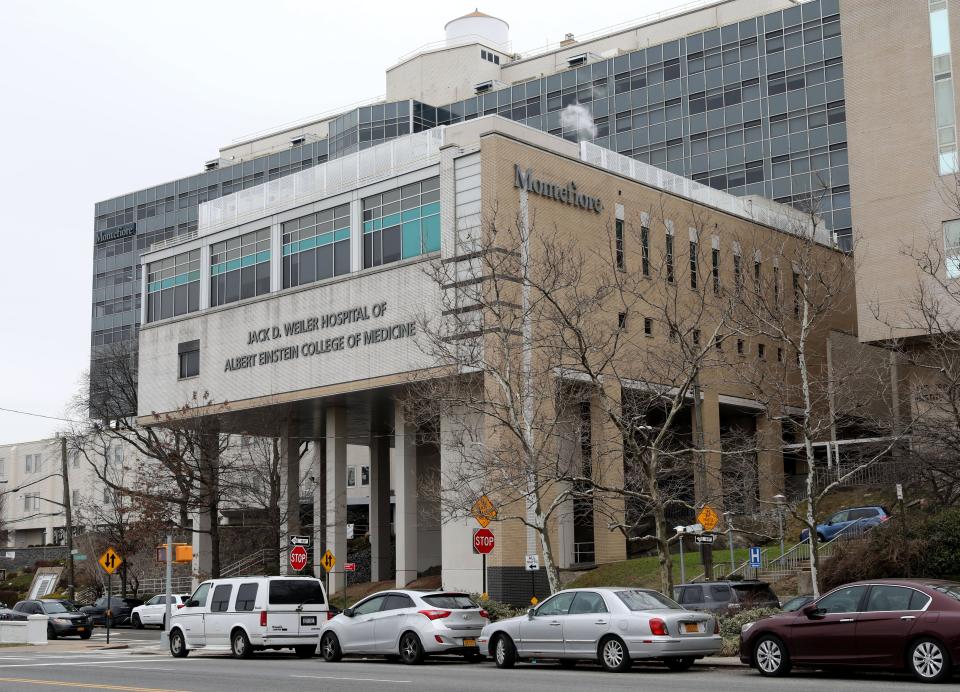Hospitals use police techniques to restrain patients, records show. Was yours one of them?
Thousands of hospital patients in New York are subjected to restraint with limited independent oversight, despite mounting concerns about racial bias and other injustices linked to the incidents, USA TODAY Network has learned.
Hospital-inspection reports obtained through public-records requests revealed at least 50 patients faced improper restraint at 15 different hospitals in New York since 2015, including several cases that suggested facilities under-reported potential abuse and neglect.
While the hospitals are implementing corrective action plans, as required to avoid losing access to Medicare and Medicaid funding, none of the facilities would provide detailed answers to USA TODAY Network New York questions about the matter.
Restrained: Thousands of patients restrained in hospital ERs and wards with limited oversight
Meanwhile, some of the inspection reports are heavily redacted and others lack many details, which underscored the limited public reporting of restraint use in hospitals. In nearly half of the instances reported below, the use of restraints or key details of the incident were not documented in the patient's medical records.
What follows are details of the hospital restraint-use violations, which were connected to a total of $54,000 in fines, as well as statements from some hospitals about the incidents provided to USA TODAY Network New York.
Some of the violation accounts include details included in federal hospital-inspection records published by the Association of Health Care Journalists.
Strong Memorial Hospital in Rochester
In April 2018, investigators found hospital security staff employed law enforcement techniques, including the use of metal handcuffs, pepper gel, batons and body strikes and holds as a means of subduing a patient and restraining a patient in 20 of 20 cases reviewed.
The use of law enforcement techniques in the healthcare setting could result in harm to patients, investigators noted. The hospital policy effectively allowed for health workers to call security to handle patients posing a danger to themselves or others. And the security staff, including armed peace officers in some cases, were trained to use law enforcement techniques to subdue patients prior to medical restraint.
In May 2017, a patient began to verbally threaten staff and refuse medication. Security staff were called to assist and used pepper gel, along with knee strikes and batons. The patient was handcuffed before being put in four-point (wrist and ankle) restraints.

In December 2017, a patient evaluated in the psychiatric emergency program was described as agitated. Security was called to assist. Security used two knee strikes to the patient’s thigh, along with a hypoglossal hold (applying pressure under the jaw). The patient was then placed in four-point restraints. The medical record, however, had no documentation of the security interventions utilized.
In January 2018, a pediatric patient under the age 19 was being evaluated in the psychiatric emergency program and became agitated upon learning she was being discharged.
Security was called and later reported arriving while the patient was banging her head against the wall. Officers put her in “bent arm bar” and waited for a restraint bed. Officers reported the patient saw the bed, began thrashing and tried to break free. While another officer tried to secure the patient's legs, a “pop” was heard. The struggle ended with the patient taken to the pediatric ER for treatment of a broken arm.
Another security report from March 2018 asserted a patient was kicking, thrashing and refusing commands. Officers used a device to fasten the patient's legs together (called a hobble) and handcuffs. When officers removed the handcuffs, the patient thrashed and officers used a mandibular angle pressure point (pressure near the ear and lower jaw) on the patient. The medical records had no documentation of the hobble or pressure-point holds.
Subscribe
Support local journalism
During a four-month span in early 2018, records show 16 patients were handcuffed, but medical records revealed no documentation of the handcuff use or the reason why they were applied in 12 of the 16 patients prior to the patient being placed in 4- or 5-point restraints.
Other findings included the lack of training for restraint use and de-escalation techniques for five security officers. And the failure to have a doctor conduct a face-to-face evaluation of a patient within 60 minutes of them being restrained in 5 of 16 cases reviewed, as required by the hospital’s policy.
In a statement about the violations, Strong Memorial Hospital noted it responded with a corrective action plan that included ongoing education and staff training aligned with state Office of Mental Health and Centers for Medicare and Medicaid Services guidelines for managing patients at risk of causing harm to themselves or others.
The plan was approved and a follow-up survey affirmed the hospital was implementing it properly, the statement added, noting a 2019 Joint Commission survey also reviewed patient safety procedures at the facility and found no areas of concern.
Good Samaritan Hospital Medical Center Islip
On July 10, 2016, a doctor ordered a patient be placed in four-point restraints at 6:13 p.m. The order called for one-on-one observation and restraint checks every 15 minutes for four hours.
But over the next almost 12 hours, records suggest the patient remained restrained without required monitoring for injury, dehydration and mental distress.
As part of the order, a nurse should have assessed the patient’s wrists and ankles for injuries, including releasing restraints one limb at a time every two hours. But records suggest only two patient check-ups occurred over the 12 hours, and the restraints were never removed.
The episode also unfolded without a doctor renewing the restraint order at least once every four hours, as required.
Further, investigators found just 13 of 61 doctors received the hospital’s annual restraint policy education.
In response to questions about the violations, Catholic Health, the parent network for the hospital, said in a statement the facility is fully accredited and in compliance with the Joint Commission.
Jacobi Medical Center in the Bronx
On Sept 10, 2016, an ambulance brought a homeless man complaining of chest pain to the ER around noon. About two hours later, he was sent to the emergency psychiatric unit, only to be transferred back to the ER for medical clearance after nearly five hours of waiting for care.
Two hospital workers and four hospital police officers were involved in moving the man between the psychiatric program and ER. At one point, they noted the man was a “flight risk” and caused a public inconvenience, alleging he attempted to grab a worker’s property and flee the hospital.

Following the exchange, the officers physically subdued the man and placed him under arrest, charging him with disorderly conduct before moving to transfer him off to ER staff.
Shortly thereafter, however, a nurse noted the man got into a physical fight with the psychiatric staff and was handcuffed by hospital police. Then, a nurse injected the man with “5 mg of Haldol (antipsychotic drug) and 4 mg of Ativan (management of anxiety)” and placed him in medical restraints of hands and wrists, at the order of a doctor.
The man’s left hand also remained handcuffed, despite the hospital’s policy prohibiting the use of handcuffs to restrain patients, records show.
Further, investigators found two other patients were restrained without the order of a doctor or other practitioner, as required by the hospital’s own policy. This included a man who arrived via ambulance with a pre-hospital identifier as an “emotional disturbed person.”
Another two patients were restrained without documentation they were monitored every 15 minutes.
And the facility failed to ensure hospital police officers involved in takedowns and restraint of patients were trained in first aid and CPR, as required.
Kings County Hospital Center
On April 23, 2016, a male juvenile alleged he was choked by a hospital police officer and wanted to file a complaint. But the incident was missing from the facility’s records on complaints. The only documented evidence of the episode was an unsigned entry in the hospital police unit’s internal incident logbook, which investigators noted failed to result in any review of the potentially improper use of a choke hold on a patient.
On Jan. 22, 2016, hospital police alleged a patient in the labor and deliver unit was acting aggressive and threatening towards them, leading them to handcuff the patient to a wheelchair. The patient suffered injuries to two fingers, requiring a gauze dressing, records show.
Investigators noted the hospital lacked written policy and procedure to guide staff on the management of patients with aggressive behavior outside behavioral health service units, though the facility did prohibit using handcuffs on patients.
Kingsbrook Jewish Medical Center
On May 8, 2016, a man with documented aggression, agitation and an altercation with a peer at a Skilled Nursing Facility was admitted to psychiatric services for psychosis and paranoid schizophrenia.
The man then had ongoing episodes of assaultive and violent behavior towards peers and sexual preoccupation towards female staff, from May 8 through Oct. 22 of that year, the records show.
One incident involved the man attacking another dementia patient who walked into his room. He punched the other man with a closed fist on the face and stomped his foot onto the side of his head, causing a head injury, including brain bleed, records show.
Shortly after the assault, the man was seen chasing a female worker in the hallway. Two male workers then escorted the man to the seclusion room, where he remained with the door closed and security officers outside the room.
No doctor’s order was issued for the seclusion, but the psychiatry unit chair later asserted the patient “wasn't in seclusion because the door wasn't locked, but we wouldn't have let him leave the area and put others at risk," records show.
The facility also lacked a written policy and procedure to guide staff on the management of patients with violent and aggressive behavior, investigators noted.
Montefiore Mount Vernon Hospital
In October 2016, investigators found 15 of 29 hospital security officers who may assist and monitor patients on restraints were not trained in the use of first aid and certified in the use of Cardiopulmonary Resuscitation, CPR, as required by state regulations.
At least five of the hospital security officers confirmed they had assisted medical workers with manual holds of patients, despite lacking the first aid and CPR training.

In a statement about the violations, Montefiore Health System, which includes hospitals in New York City and Westchester and Rockland counties, noted its guidelines are in accordance with the state Health Department standards.
The system added its staff are trained annually to ensure that when required, restraints are applied in the safest, most humane manner.
“Like other hospitals, Montefiore’s goal is to be a restraint-free organization, however, restraints and seclusion are necessary at times to ensure the safety of patients who are at greatest risk of harming themselves or others,” the system added.
Montefiore Medical Center – Jack D. Weiler Hospital of Albert Einstein College Div Bronx
In 2017 a woman arrived for a scheduled outpatient visit in the psychiatric unit. She had a medical history of schizoaffective and bipolar disorder.

During her visit with the psychiatrist, she became agitated and combative, and four security officers and a physician took her to the emergency department for evaluation. About 20 minutes later she was place in the ED’s seclusion room for aggressive and combative behavior. She spent nearly two hours in seclusion, despite no evidence of a doctor’s order for the seclusion or monitoring every 15 minutes.
During the episode, the woman complained to three different hospital workers that she had been punched in the face five times by a security officer, and a physician ordered an x-ray that found “traumatic hematoma” of the right eye. But the hospital failed to investigate the patient’s complaint until after the inspection cited the issue.
NewYork-Presbyterian Queens
In February and March 2017, a total of six patients were restrained without evidence that a doctor or other licensed provider examined them before the restraint session was extended.
In another incident, a patient spent four hours in mitten restraints without the required order of a doctor or licensed provider.
NewYork-Presbyterian Hospital in Manhattan
In 2016, investigators found two patients were restrained without ensuring it was in accordance with the order of a doctor or other licensed provider as required.
The first patient with a history of alcohol abuse and depression was restrained by hospital security officers after allegedly kicking and screaming at hospital workers. Investigators noted a doctor order for the restraint was timestamped for after the four-point restraint was applied.
The other patient was a nursing home resident with dementia who was brought to the emergency department for evaluation. The cited reason for the transfer was that he was agitated and hitting nursing home staff.
Before arriving at the hospital, the man was given Seroquel (antipsychotic medicine). He arrived at the ED asleep and had limited verbal response once awoken. Nearly three hours later, hospital security restrained the man for refusing to change into a hospital gown without a written order, and he was changed into the gown by a hospital worker, records show.
Another patient with dementia and Parkinson’s disease was brought to the hospital by ambulance with the chief complaint of agitation. A triage nurse noted the patient was agitated and at risk of elopement and placed in four-point restraint by EMS. It occurred before a nurse completed an assessment of the patient and without documentation of the steps or interventions used prior to the use of restraint or seclusion.
St. Charles Hospital in Port Jefferson
In January 2016, a man “swinging at staff members with his fists” was placed in four-point restraints. About six hours later, a doctor appeared to retroactively issue an order for the restraint but recorded it as “all side rails.” The man spent a total of nine-and-a-half hours in four-point restraints.
On March 2 of that same year, another man was placed in four-point restraints after he was threatening to staff, records show, but a doctor’s order wasn’t secured for the restraint until about two hours later. The man spent a total of nine hours in four-point restraints.
In response to questions about the violations, Catholic Health, the parent network for the hospital, said in a statement the facility is fully accredited and in compliance with the Joint Commission.
St. Joseph’s Medical Center in Yonkers
In April 2016, investigators reviewed records and interviewed hospital security officers, revealing three cases where officers used handcuffs to restrain patients in violation of state regulations. One incident involved a patient being handcuffed after a security officer was injured during a prior attempt to restrain the patient.

Investigators also reviewed records that showed seven hospital security officers who assist health providers in restraining patients lacked training on restraint use, including the lack of first aid and CPR training. One incident involved a man who threw a chair against a wall before being restrained by a security office, two EMTs and a nurse. Another involved a man who was restrained and “medicated” after attacking two fellow patients.
University Hospital Stony Brook
In November 2016, investigators found the hospital’s nursing staff – as well as all 44 hospital security officers and all 64 nursing assistants – lacked demonstrated restraint competencies.
The investigators cited several cases, including six patients placed in restraints in the emergency department in 2016. The medical records lacked evidence that the patients were properly monitored, including offering hydration. One of those patients spent 11 hours in restraints, investigators noted.
The cases violated the hospital’s own policy requiring patients in restraints be monitored “as often as necessary to assure safety, dignity, and attend to comfort needs", and "Every 15 minutes" restraint documentation should include "hydration,” investigators noted. The hospital also failed to follow its policy mandating annual assessments of restraint use competency of all staff involved in the technique.
St. John’s Episcopal Hospital – South Shore Far Rockaway
In 2017, hospital workers told investigators that a female patient grabbed the hair of a hospital worker and choked a behavioral health associate.
Four other hospital workers watched the violent incident unfold but declined to assist, saying they had been advised against it until receiving training. The altercation included a five-minute span in an apparent blind-spot in video surveillance footage and ended with the patient being escorted to her room by two hospital workers.
The entire unit, including the two workers directly involved in the altercation, had not received de-escalation training, investigators noted.
Erie County Medical Center in Buffalo
In 2016, investigators reviewed an altercation between a hospital public safety officer and a female pediatric patient.
The patient assaulted another patient before the safety officer and other hospital workers attempt to restrain her. The female pediatric patient begins kicking and grabbing the safety officer, who then tries to handcuff her. The patient bites the officer’s right arm, and the officer then “strikes (her) in the face three times” before getting pulled away by another hospital worker, records show.
Investigators found the security officer and six other security officers had not received the hospital’s training in preventing and managing a crisis situation as required. Overall, 26 of 62 security officers and public safety assistants at the hospital had not received the training within the last year as required, they added.
St. Joseph’s Hospital Health Center in Syracuse
In 2017, investigators found 24 of 34 hospital security officers and security staff lacked required first aid and CPR training related to their duties for restraint and seclusion.
An inspection also cited one violation involving a physician assistant ordering patient be placed in a vest restraint for 24 hours without documentation that the patient’s attending physician was notified of the restraint. The hospital’s policy also incorrectly stated that notifying the attending physician of a restraint was not required, investigators noted.
David Robinson is the state health care reporter for the USA TODAY Network New York. He can be reached at drobinson@gannett.com and followed on Twitter: @DrobinsonLoHud
About the team
New York’s USA Today reporting teams are working on a series of wide-ranging investigations intended to shine a light on processes that are critical to public life but are often hidden. The topic areas for 2022 include government accountability and oversight, policing and public safety, health and environmental justice and consumer rights. We welcome your feedback and suggestions to help inform our reporting priorities.
Email: nyinvestigationtips@gannett.com.
This article originally appeared on New York State Team: At least 15 hospitals violated guidelines for patient restraint records show

